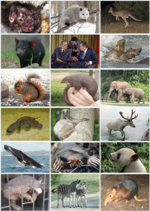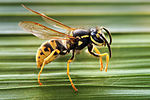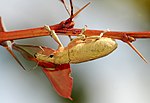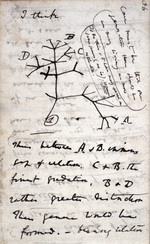 | Sociality (section Eusociality) acknowledged degree of sociality. Eusociality has evolved in several orders of insects. Common examples of eusociality are from Hymenoptera (ants, bees... 29 KB (3,103 words) - 13:13, 17 April 2024 |
 | Bee (section Eusociality) nine) evolutions of eusociality within Hymenoptera. Haplodiploidy is neither necessary nor sufficient for eusociality. Some eusocial species such as termites... 117 KB (12,149 words) - 17:53, 7 April 2024 |
Synalpheus regalis (section Eusociality) heterospecific intruders. This evidence points towards the first known case of eusociality in a marine animal. The species name "regalis" comes from the Latin regalis... 20 KB (2,383 words) - 16:34, 5 December 2023 |
 | Austroplatypus incompertus (section Eusociality) Hymenoptera (bees and ants) and Isoptera (termites) to exhibit eusociality. Eusocial insects develop large, multigenerational cooperative societies that... 24 KB (3,061 words) - 22:41, 25 April 2024 |
 | Bird colony Clonal colony Coenocyte Colonisation (biology) Coral reef Eusociality Superorganism Swarm Birth colony Austroplatypus incompertus Jackson,... 16 KB (1,851 words) - 21:53, 4 February 2024 |
 | Kladothrips (section Eusociality) Hymenoptera (bees, wasps, and ants) and Isoptera (termites) that exhibit eusociality. Eusocial insects are animals that develop large, multigenerational cooperative... 9 KB (1,121 words) - 12:32, 3 April 2024 |
 | Halictidae (section Eusociality) within the colony. Primitively eusocial species such as these provide insight into the early evolution of eusociality. Halictus sexcinctus, which exhibits... 17 KB (1,626 words) - 19:07, 5 January 2024 |
 | Beetle (section Eusociality) definition of eusociality". Behavioral Ecology. 6 (1): 109–115. doi:10.1093/beheco/6.1.109. Kent, D. S. & Simpson, J. A. (1992). "Eusociality in the beetle... 155 KB (16,863 words) - 15:49, 28 April 2024 |
 | mole-rat (Fukomys damarensis) the only widely recognized examples of eusociality (the highest classification of sociality) in mammals. The naked mole-rat... 47 KB (5,402 words) - 16:05, 16 April 2024 |
 | Halictinae (section Eusociality) with other inferred eusociality origins. Thus, the Halictinae are believed to model the primitive eusociality of advanced eusocial hymenopterans. Because... 24 KB (2,795 words) - 14:18, 21 June 2023 |
 | Synalpheus (section Eusociality) radiations between 3 and 9 mya from which the ancestors of these eusocial species appeared. Eusociality is thought to have arisen due to competition for space,... 10 KB (894 words) - 13:15, 8 November 2023 |
organisms. Other problematic cases include colonial organisms; a colony of eusocial insects is organised adaptively, and has germ-soma specialisation, with... 22 KB (2,020 words) - 14:45, 29 April 2024 |
 | Kin selection (section Eusociality) selection have crumbled" and that he now relies instead on the theory of eusociality and "gene-culture co-evolution" for the underlying mechanics of sociobiology... 63 KB (7,590 words) - 20:14, 24 February 2024 |
 | "Ancestral Monogamy Shows Kin Selection Is Key to the Evolution of Eusociality". Science. 320 (5880): 1213–1216. Bibcode:2008Sci...320.1213H. doi:10... 134 KB (12,771 words) - 23:14, 28 April 2024 |
 | Suzanne Batra (section Eusociality) work on the classification of insect societies and for coining the term eusociality. Batra graduated from Saranac Lake (New York) High School in 1956 and... 4 KB (442 words) - 02:28, 14 April 2024 |
 | stage); common bottlenose dolphins; orcas; and false killer whales. Eusociality is the highest level of social organization. These societies have an... 212 KB (22,683 words) - 14:21, 20 April 2024 |
 | analysis supports the single origin of eusociality hypothesis within the corbiculate bees, where eusociality evolved in the common ancestor of Bombini... 106 KB (11,481 words) - 02:04, 1 April 2024 |
 | diverse, cosmopolitan family of wasps, including nearly all the known eusocial wasps (such as Polistes fuscatus, Vespa orientalis, and Vespula germanica)... 6 KB (634 words) - 09:25, 19 October 2023 |
 | Bombus ternarius (section Eusociality) genus Bombus, live in eusocial colonies in which the individuals in the group act as a single multiorganismal superorganism. Eusociality may have evolved in... 31 KB (3,942 words) - 00:45, 28 June 2023 |
 | (non-feeding). Some larvae are dependent on adults to feed them. In many eusocial Hymenoptera species, the larvae are fed by female workers. In Ropalidia... 15 KB (1,339 words) - 01:15, 10 April 2024 |
Georg; Yamamoto, Shûhei (29 July 2022). "Evidence for the evolution of eusociality in stem ants and a systematic revision of † Gerontoformica (Hymenoptera:... 149 KB (16,685 words) - 21:00, 30 April 2024 |
 | Hornets (insects in the genus Vespa) are the largest of the eusocial wasps, and are similar in appearance to their close relatives yellowjackets. Some... 26 KB (3,014 words) - 02:13, 1 April 2024 |







